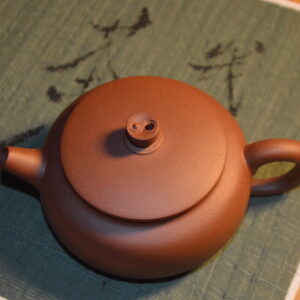Description
Origin: Dingshu, Yixing Town
Material: mix purple purple-clay (Zisha)
Material: mix purple purple-clay (Zisha)
Color: dark brown
Size: 12.5cm*8.5cm*6.5cm (150ml)
Shape: flat lid lotus seed (Pinggai Lianzi)
Firing temperature: up to 1050℃~1200℃
Shape: flat lid lotus seed (Pinggai Lianzi)
Firing temperature: up to 1050℃~1200℃
Time: autumn-winter 2021
Design: Wenzhuo Liu 劉文卓
Artisan: Aizhen Ding 丁爱珍
Artisan: Aizhen Ding 丁爱珍
Direction: Purple-clay teapots retain flavor well; one should dedicate each teapot to a specific type of tea (black, oolong or dark tea) so that the flavor doesn’t become corrupted. Never wash clay pots with Soap.
Introduction:
Taiji 太极 (Yin-Yang Diagram) is on the lid button.
Engraving means carving words or pictures on wood or stone with a knife, as is the case with the engraved Zisha pottery, that is, carving words and pictures on the walls of Zisha pottery. Engraving is a very common decoration technique and the main form of the decoration of Zisha teapots, by leaving poems and songs, flowers, birds, insects and fish, and landscape and figures on teapots, the art of literature, calligraphy, painting and seal cutting has been added to the teapots.
Zisha Dui Ni, colored clay laying painting is a school of techniques that combines Chinese painting with Zisha clay. It is different from pottery carving, but it is really painted on the teapot body, Zisha and colored clay pile painting. The art of pile painting of Zisha colored clay began in the Yongzheng period of the Qing Dynasty. It takes different colored clay as ink, based on traditional Chinese painting techniques, and uses knives and pens to pile and draw on the potter body with a certain humidity. Relying on the thickness of clay and the performance effects of different colors of clay, it can show the charm and artistic conception of Chinese traditional pen and ink. Like bas-relief, it has a distinct sense of layers, elegant taste and far-reaching artistic conception.
Purple-clay 紫砂 [zǐ shā] is famous of high in iron and silicon contents, featuring high plasticity, the glossier surface the more useages of brewing tea. Tea sets made from purple-clay is not normally glazed. A finished product is primarily purple, thus it is named. This pottery can be divided into different colors, such as purple-brown “purple clay” which is in amaranth or light purple; gray-yellow “green clay” in gray or gray-blue; vermeil “red clay” in red-brown. Purple-clay tea set has a long history in China. Su Shi, the great scholar of the Song Dynasty, had designed a pot with handle, called “Dongpo Pot with Loop Handle”. In the Ming Dynasty, making loose tea in a small pot was popular, which led to the development of purple-clay pots.






























